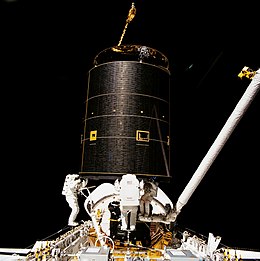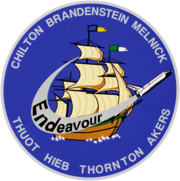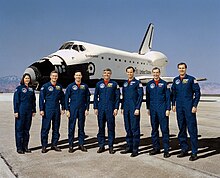 | |
| Names | Space Transportation System-49 |
|---|---|
| Mission type | Intelsat 603 satellite repair |
| Operator | NASA |
| COSPAR ID | 1992-026A |
| SATCAT no. | 21963 |
| Mission duration | 8 days, 21 hours, 17 minutes, 39 seconds |
| Distance travelled | 5,948,166 km (3,696,019 mi) |
| Orbits completed | 141 |
| Spacecraft properties | |
| Spacecraft | Space Shuttle Endeavour |
| Launch mass | 116,390 kg (256,600 lb) [1] |
| Landing mass | 91,279 kg (201,236 lb) |
| Payload mass | 16,984 kg (37,443 lb) [2] |
| Crew | |
| Crew size | 7 |
| Members | |
| EVAs | 4 |
| EVA duration |
|
| Start of mission | |
| Launch date | May 7, 1992, 23:40:00 UTC (7:40 pm EDT) |
| Launch site | Kennedy, LC-39B |
| Contractor | Rockwell International |
| End of mission | |
| Landing date | May 16, 1992, 20:57:39 UTC (1:57:39 pm PDT) [3] |
| Landing site | Edwards, Runway 22 |
| Orbital parameters | |
| Reference system | Geocentric orbit |
| Regime | Low Earth orbit |
| Perigee altitude | 268 km (167 mi) |
| Apogee altitude | 341 km (212 mi) |
| Inclination | 28.32° |
| Period | 90.60 minutes |
| Instruments | |
| |
 STS-49 mission patch  From left: Thornton, Melnick, Thuot, Brandenstein, Chilton, Akers and Hieb | |
STS-49 was NASA's maiden flight of the Space Shuttle Endeavour, which launched on May 7, 1992. The primary goal of its nine-day mission was to retrieve an Intelsat VI satellite, Intelsat 603, which failed to leave Low Earth orbit two years before, attach it to a new upper stage, and relaunch it to its intended geosynchronous orbit. After several attempts, the capture was completed with the only three-person extravehicular activity (EVA) in space flight history.[4] It would also stand until STS-102 in 2001 as the longest EVA ever undertaken.
- ^ "Space Shuttle Missions Summary". NASA. Retrieved February 8, 2022.
 This article incorporates text from this source, which is in the public domain.
This article incorporates text from this source, which is in the public domain.
- ^ "Space Shuttle Missions Summary" (PDF). NASA. Retrieved February 8, 2022.
 This article incorporates text from this source, which is in the public domain.
This article incorporates text from this source, which is in the public domain.
- ^ Cite error: The named reference
Reportwas invoked but never defined (see the help page). - ^ "Facts about spacesuits and spacewalks". June 3, 2013. Archived from the original on June 3, 2013. Retrieved February 8, 2022.
 This article incorporates text from this source, which is in the public domain.
This article incorporates text from this source, which is in the public domain.